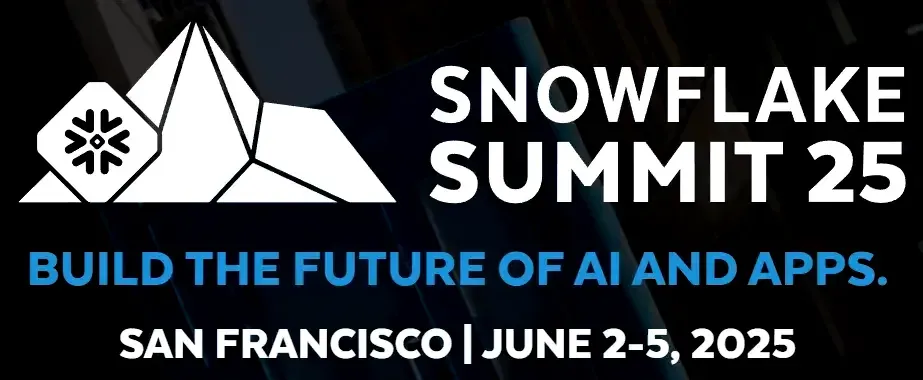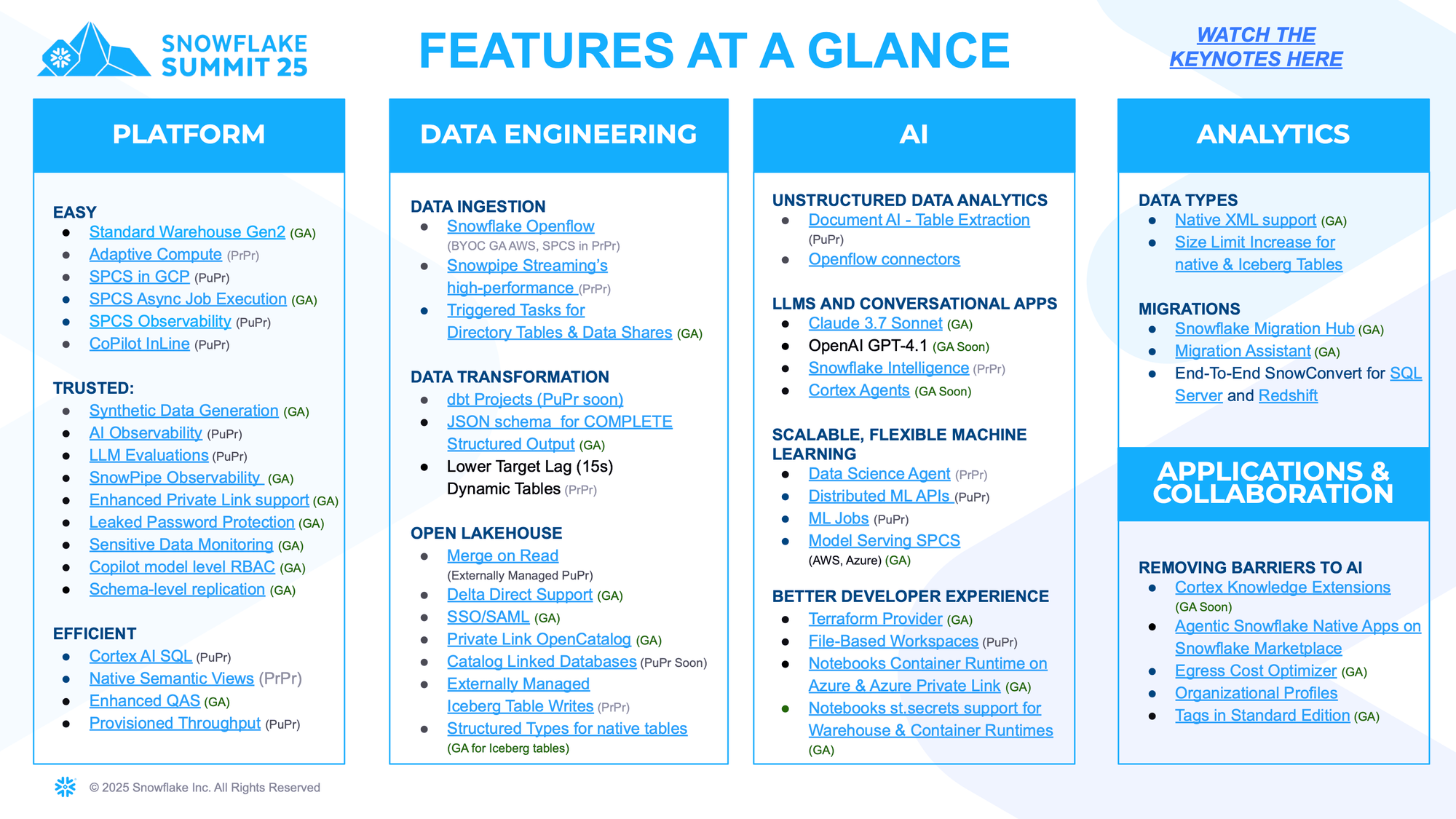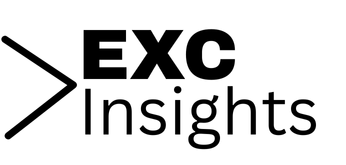Snowflake Summit 2025 - EXC Summary

This summary synthesizes the key themes, announcements, and strategic directions presented during the Snowflake Summit 2025. A central thread across all presentations is the pervasive impact of AI on the data landscape, fundamentally changing how data is managed, processed, and leveraged for business outcomes.

You can also check the EXC Talk episode
I. The Dawn of the AI Data Cloud: A Unified Vision
Snowflake is positioning itself as "the place where data does more," evolving into the "AI Data Cloud." This vision centers on making data and AI "easy, connected, and trusted."
- Simplicity and Ease of Use: A core product value from Snowflake's inception, simplicity is now critical in the age of AI. The goal is to make complex AI capabilities feel effortless, enabling users to "ask a question with a voice memo and get an answer on your enterprise data" or "launch a customer app without having to write a line of code." (Sridhar Ramaswamy, Opening Keynote)
- Connected Ecosystem: Snowflake aims to break down data silos, fostering collaboration and open data sharing across teams, departments, and organizations. The Snowflake Marketplace is a key component, with over 3,000 listings from 750+ partners, enabling secure sharing of data, apps, and models.
- Trust and Governance: Emphasizing "enterprise-grade trust," Snowflake ensures that LLMs and applications run within its governed perimeter. This includes "built-in governance, always-on security, and automated compliance and recovery," which is crucial for handling sensitive and personal information, as validated by certifications like the Department of Defense IL5 authorization. (Sridhar Ramaswamy, Opening Keynote)
II. AI's Transformative Impact on the Software Development Lifecycle (SDLC)
AI is fundamentally reshaping nearly every phase of the SDLC. A "refreshed software development life cycle" was introduced, adding an "architect" stage emphasizing optimal data architecture for future-proofing systems.
- Pervasive AI Influence: "Regardless of whether you're actually building out an AI based application nearly every phase of how we build applications is changing because of AI co-pilots." (Danica, Builder Keynote)
- Empowerment over Fear: While 72% of surveyed organizations anticipate handing off tasks to autonomous agents by year-end, Snowflake encourages an empowered perspective, seeing it as an "opportunity ahead of you in this new era of technology." (Danica, Builder Keynote)
- Focus on Core Roles - AI agents are changing workflows for:
- Analysts and Data Scientists: Simplifying complex problems, gathering insights, and influencing business decisions by changing "not only how you work with your data but also how you work with your stakeholders." (Danica, Builder Keynote)
- Data Engineers: Adapting architectures to meet "new and different demands" from AI. (Danica, Builder Keynote)
- AI and ML Engineers: At the "bleeding edge," embracing AI for application development and working directly with AI models. (Danica, Builder Keynote)
III. Key Product Announcements & Enhancements Driven by AI
Snowflake unveiled a host of new features and capabilities, largely centered around making AI accessible, efficient, and secure within its platform.
A. Empowering Agentic Analytics
- Snowflake Intelligence: A new UI layer, now in public preview, allowing "anyone in your organization to start working with agents across your organization." (Jeff Holland, Builder Keynote; Christian Kleinerman, Platform Keynote) It provides an "out-of-the-box experience" for business users to interact with data.
- Cortex AI Platform: The underlying robust platform for building and scaling agentic systems.
- LLM Advancements: LLMs can now "reason, use tools to perform tasks, make decisions on which tools to use all completely autonomously," moving beyond general knowledge sharing. (Jeff Holland, Builder Keynote)
- Guardrails & Accuracy: New tools like Semantic Views allow defining custom attributes, instructions, and "verified queries" (source of truth SQL) to ensure accurate and consistent data representation for agents.
- Cortex Search API with Arctic Embed Model: Facilitates pulling meaning from unstructured data (documents, images, audio). The Arctic Embed Model is "fully open sourced on hugging face for anybody to benefit and build on." (Jeff Holland, Builder Keynote)
- Cortex Agents: Now generally available, these agents orchestrate and reason based on diverse backends and datasets, enabling the creation of agentic applications. They can invoke other tools and agents.
- Cortex AI SQL: A new AI query language (private preview) that allows users to "use natural language in our SQL queries." (Mo Kiss, Platform Keynote) It enables:
- Multimodal analytics across text, image, and audio files using functions like AI Complete.
- Semantic joins based on natural language prompts, dynamically routing tasks for efficiency.
- Aggregated insights across large tables using AI Aggregate, handling context window limitations.
- Semantic Views & Semantic SQL: A new view type to capture business context, metrics, dimensions, and definitions, translating them to physical schemas. Semantic SQL provides a richer query set using these views. These views can also be shared via the Marketplace.
- Cortex Knowledge Extensions: Now generally available, these allow publishing vectorized data, ready to be queried by Cortex Search, including content from news providers like USA Today and Associated Press.
B. Enhanced Developer Experience & Tools
- Streamlit in Snowflake: Now generally available on Private Link for AWS and Azure. Many open-source features are also generally available, including file upload, camera input, and advanced theming. Git integration and multi-file editing are in public preview. Snowflake announced the formation of a Streamlit steering committee for broader community involvement.
- Snowflake Notebooks: Now generally available on AWS, Azure, and GCP, with private connectivity. They support container runtime for flexible compute environments, optimizing advanced data science and ML workloads.
- Snowflake Workspaces: A new "one-stop UI to work across all of your Snowflake files," offering improved SQL support, dbt project integration, external Git integration, side-by-side diffs, charts, and an inline AI copilot (Control K).
- Programmatic Access Tokens & OAuth: New, more secure ways to connect to Snowflake, coming to private preview.
- Custom Git URLs: Users can now host Git repositories wherever they want, not just GitHub.
- Data Science Agent (private preview): An AI assistant to help build ML pipelines from inception to production.
C. Evolving Data Architecture & Infrastructure
- OpenFlow: A new managed service that helps ingest and process multi-modal data from various sources (e.g., SharePoint, Slack, Google Drive) and supports different deployment choices (Snowflake managed or custom VPCs). It's built on Apache NiFi.
- Document AI: Expanded capabilities for integrating and ingesting semi-structured and unstructured data, allowing extraction and transformation into structured tables.
- Real-time & Streaming Data: OpenFlow and a "full new rev of Snowpipe streaming" support high-throughput, low-latency data ingestion, making data queryable within 5-10 seconds.
- Apache Iceberg & Open Catalog (Polaris): Snowflake is deeply committed to open standards, integrating with and contributing to Apache Iceberg and Apache Polaris. New features include reading row-level and positional delete files, automated table maintenance via Apache Polaris and Open Catalog, and support for Iceberg V3 table spec data types like geometry and variant.
- Snowflake Postgress: Snowflake's agreement to acquire Crunchy Data brings open-source PostgreSQL technology into the Snowflake ecosystem, providing a managed PostgreSQL service with Snowflake's enterprise capabilities for transactional data, application development, and agent state.
- DBT Projects in Snowflake: An authoring environment for building, testing, and deploying dbt pipelines directly within Snowflake, now in public preview. Future versions will integrate with DBT Fusion engine.
- Adaptive Compute: A "next generation compute level" (private preview) where Snowflake automatically selects and scales compute resources based on policies and intent, aiming for "easier to manage, you'll get better performance and very important you'll get better utilization." (Christian Kleinerman, Platform Keynote)
- Simplified Ingest Pricing: A new model based on data volume ingested, aiming for "roughly 50% better economics" compared to the previous per-file and compute cost model. (Christian Kleinerman, Platform Keynote)
- Generation 2 Warehouses: A new iteration of traditional warehouses with "faster hardware, a lot of software optimizations," showing "2.1x faster performance" compared to previous Snowflake benchmarks and 1.9x faster than managed Spark for scanning Parquet files in Iceberg tables. (Christian Kleinerman, Platform Keynote)
- Snow Convert & Snow Convert AI: Snow Convert, a tool for migrating data and code to Snowflake, is now free. Snow Convert AI leverages AI to automate testing and validation during migrations.
D. Strategic Partnerships & Community Initiatives
- OpenAI Partnership (Sam Altman): OpenAI's CEO emphasized the rapid maturation and reliability of LLMs for enterprise use cases, advocating for companies to "make the early bets and iterating very quickly." He anticipates models will soon "go figure out things that teams of people on their own can't do."
- Whoop Case Study: Matt Luigi, Senior Director of Analytics at Whoop, demonstrated their internal LLM-powered agentic analytics system built on Snowflake, empowering employees with no-code data access and freeing up data teams for strategic work. They use Cortex Search for unstructured data and semantic models for structured data, with Streamlit as a flexible UI layer.
- AstraZeneca Case Study: Brian Dumman, CEO of AstraZeneca, highlighted how Snowflake (and OpenFlow) helps them integrate diverse data sources, reduce costs, and accelerate drug development by making data "AI ready" and bringing AI to the data.
- Marriott International Case Study: Julia Morrison, from Marriott International, discussed how Adaptive Compute will simplify the management of compute resources at scale.
- Canva Case Study: Mo Kiss, Director of Data Science at Canva, demonstrated Cortex AI SQL for multi-modal analytics, semantic joins, and aggregated insights using natural language.
- New York Stock Exchange (NYSE) Case Study: Lynn Martin, President of NYSE Group, detailed how Snowflake helps them manage "1.2 trillion incoming order messages a day," ensuring market integrity, efficient risk management, and driving innovation through AI in a tightly regulated industry. She advises leaders to "stick to your core principles" when rolling out AI.
- Luminate Case Study: Showcased building a conversational AI interface on Snowflake's AI Data Cloud, leveraging Cortex AI for accurate insights from structured and unstructured entertainment industry data.
- Silicon Valley AI Hub: Snowflake is opening a 28,000 sq ft space in Menlo Park to foster AI innovation and collaboration among developers, startups, and business leaders.
III. Key Quotes
- "We are innovating at a pace faster than any other company on the planet and I couldn't be more proud of our progress." – Sridhar Ramaswamy, Snowflake CEO
- "There is no AI strategy without a data strategy. Data is the fuel for AI." – Sridhar Ramaswamy, Snowflake CEO
- "At Snowflake we help remove friction break down silos and make the complex feel effortless we help you unlock outcomes with data that were previously unimaginable snowflake is the place where data does more." – Sridhar Ramaswamy, Snowflake CEO
- "The technology is also rapidly maturing... this technology is actually ready for mainstream usely." – Sridhar Ramaswamy, Snowflake CEO
- "Simplicity has been a core product value for Snowflake and when Terry and I founded Snowflake analyzing data at scale was really so complex that only few companies in the world could do it instead we wanted to make this process easy so that any organization could leverage all of its data and more simplicity represent just one of our values equally important to our commitments is to make snowflake both connected and govern and now we want to do the same with AI like data AI should be easy connected and trusted." – Benoit Dageville, Snowflake Co-Founder
- "Agentic systems have taken LLM use on a totally different trajectory now that LLMs can use tools they are becoming a lot more useful." – Yuzf Usall, Snowflake Cortex
- "The models over the next year or two years are are going to be quite breathtaking... businesses can just do things that totally were impossible with the previous generation of models." – Sam Altman, OpenAI CEO
- "It's about setting context... I think of search as a tool for setting attention for a model." – Sridhar Ramaswamy, Snowflake CEO
- "We are truly early on in this journey with AI so the outcome of this transition hasn't fully been seen yet. We don't really know where it's headed but that should be an exciting opportunity for all of you here in this room." – Danica Fine, Snowflake
IV. Outlook and Call to Action
Snowflake views the current era as a "phase transition" where data roles and responsibilities are changing with and around AI, leading to a "convergence towards data engineering best practices." The path ahead is uncertain, but the opportunity for builders is immense. Snowflake encourages its community to "get building" with the provided tools and resources, emphasizing that every bit of code and demo from the keynote will be available for exploration and building upon. The overall message is one of inspiration, collaboration, and continuous innovation in an AI-first world, with Snowflake providing the unified platform to navigate this transformation.
